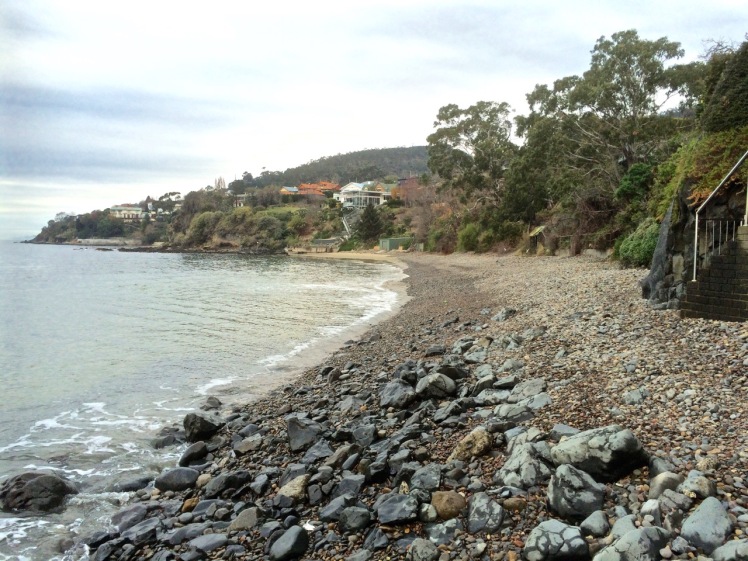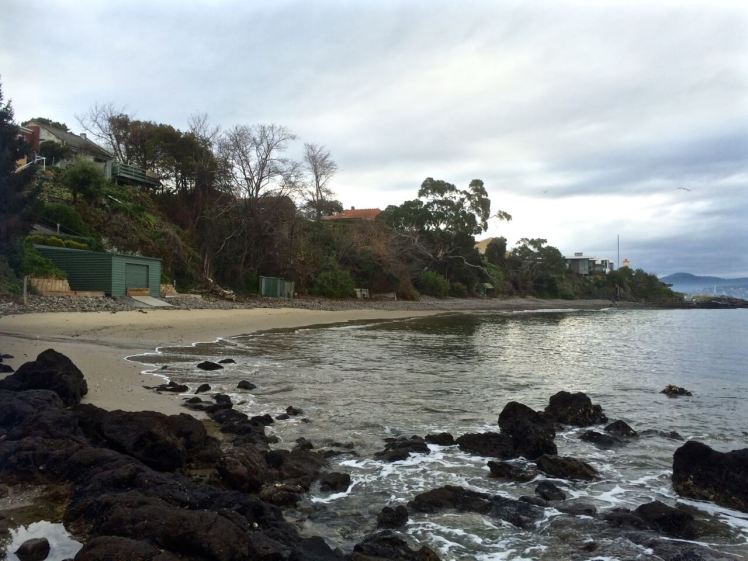Into the Volcano
June, 2015
I woke with a huge sense of anticipation about this next walk, keen to get going, but the aroma of coffee filled the kitchen, scrambled eggs were on offer and the woodheater warmed the house. The flame robin in the garden seemed an auspicious omen and so I breakfasted at home in preference to stopping by a Long Beach cafe.
I saw yachts sailing before a light northerly breeze as I approached my starting point. The sky was a milky dome of cloud and the landscape was quiet and dreamy. It stayed that way all day and the mountain was hidden from view except for occasional glimpses of forested flank through small gaps in the clouds.
There were plovers on the beach and a lone cormorant fishing as I set off down the path from Long Beach and soon I was swinging around Blinking Billy Point into Geography Bay, the old lighthouse on my right pressed up against the houses, past the old search light and the Charles Darwin Cliffs and down on to Blinking Billy Beach, the small waves breaking on the pebbles and little sand evident because the winter river had drowned the beach.
I had not always known this was the case. I thought it’s disappearance indicated climate change, but the Salty Seadog had once told me it went submarine in winter. On rough, wintry days the beach makes music, the cobbles rolling in the waves. The Salty Seadog writes music and plays music so I guess it’s her kind of beach.

I’d walked this coastline by the time I discovered Lena Lencek’s book The Beach: The History of Paradise on Earth (2009) as an audio recording on Scribd, my new favourite app. She’d spent her childhood in Trieste, enjoying the Adriatic coast and then her family moved to the USA and she got to know vastly different kinds of beaches. Listening to this book at night, speakers in my ears, I learned about pocket beaches, and the landscape I was walking fell into place.
A pocket beach is normally a fairly thin, crescent shaped beach nestled between rocky headlands. It’s possible to find strings of them along coastlines – beach, headland, beach – and although they are sedimentary (the sand, shell and pebbles laid down in beautiful layers by water) the headlands, and the rocky platforms at their feet, isolate the beaches from each other, and that means they can be subjected to different types of beach making and breaking processes, like the angle of waves and higher tides in winter which often cause them to disappear. (And if, like me, you’d forgotten that tides are higher in winter, it’s because the sun, like the moon, has an influence on tides and in winter we’re tilted further away from the sun and so it’s gravitational pull is much slacker and the tides aren’t drawn back quite as much.)
I was so excited by this concept of pocket beaches that I just had to enlighten the geologist. ‘I’m sure Blinking Billy is a pocket beach,’ I enthused.
He looked at me bemused. ‘We’re surrounded by pocket beaches,’ he said. ‘There are heaps of pocket beaches along the Derwent. Name any one. Chances are it’s a pocket beach.’ And thus began a second lesson in all things pocket beach and Derwent River. I listened, but at the same time I was hatching a plan to subvert the concept – each beach in my pocket. I ordered vials off Etsi and began to gather each beach’s signature, it’s fingerprint in these tiny bottles. Because this is the thing – the sand on each beach is different and after all, one day these beaches will really drown.
It’s a short walk from one end of the first Blinking Billy beach to the other but a little longer when the sand is submerged and you’re walking on cobbles. At the far end I made a voice memo: ‘I’m about to go where I have never been before’. That was because I’ve always been here with dogs, and I’ve always stopped obediently at the sign commanding no dogs to go any further because of seabird habitat.

I may never have been here but I knew that Darwin had. He’d sailed into Hobart on the Beagle in 1836 and been pretty unimpressed with the town initially but this changed as walked about. He headed up the mountain, guided by the Sandy Bay Rivulet (my first recorded walk), he walked along the river’s eastern shore where I’m currently spending a bit of time and he walked this coastline too. I felt he was a suitable companion in spirit because he had the observant eye I lack and was able to make sense of the Derwent’s complex geology in a way I could not. He’d named kunanyi/Mt Wellington Table Mountain, after another mountain I have lived beneath and his grandfather Erasmus and my sister both made Lichfield their home. If he was up for a little idle chatter, conversation should flow. And there were moments on this walk when the landscape felt so timeless I felt I could well have encountered him contemplating pebbles and stones on some of the wilder sections.
Such was his observant eye that on his fifth day here he found volcanic rocks near Blinking Billy Point on his walk from Battery Point to Sandy Bay and realized that the cliff revealed two lava flows and that volcanic rocks lay strewn about. ‘Hah!’ was his reaction (or something like this). ‘I’m standing in the eroded heart of an ancient volcano!’ He figured this out way back then yet many locals are unaware of this even today.
I’d stumbled into the heart of the volcano often and unknowingly, oblivious to the story the Charles Darwin cliffs were telling, more concerned about the smelly water that seems to be deposited straight onto the concrete path from a house above the cliffs and so the fact that Hobart is situated on the remnants of a volcano was news to me when, after this walk, I tried to make sense of it all. The reef extending out to the John Garrow Light is an old lava flow and fault lines abound through this area.
I rounded the point at the end of the beach. There, before my eyes, was another beach – Blinking Billy Beach 2, according to Short or Half Moon Bay, according to Leaman (1999). In the distance, a man in a red jumper was throwing sticks for his dog. I navigated a bit more reef and cobbles then stepped on to the sand.

A cockatoo flew overhead, yelling for its mob. And then again more pebbles and then another sandy stretch and another six private stairways down onto the beach. I noticed a rivulet. This is poor little Folder Rivulet, according to Andrew Short, emerging out of its drain into sunlight, unloved and disregarded, too tiny to matter. (I watched this little rivulet being bulldozed unceremoniously into its drain, back in the day. It looked so wrong it hurt. And recently I returned to its valley to try to discover how much of it can still be seen above ground. Not much.) We communed, the rivulet and I, and then I took photos of beautiful conglomerate rocks and and made another voice memo:
I’m on another sandy cove with some interesting old beach structures. It’s quite a long sandy cove with a rocky reef in the centre of it. As I walked along the second stretch of sand a white speed boat came up river and the yacht I’d thought was leading the race (they rounded the buoy at Nutgrove all bunched up) has proceeded on down the river with its spinnaker up… this is such a lovely walk.’

And it was true; I felt elated, thrown back into childhood recollections of The Famous Five and their explorations which we tried to mimic on holidays on South Africa’s eastern seaboard. I felt invigorated by a sense of adventure and discovery and on this beach there were so many new discoveries – new perspectives of the river and tiny, exquisite details.
Here’s the southern end of the beach, and the man and the dog had already disappeared around the corner.


The reef at this end of the beach held my attention for quite some time. The rocks were interesting, human debris, although depressing, also managed to look artistic and I began to do a little bit of amateur geological sleuthing perplexed by rocks that didn’t always seem to belong together – sedimentary, conglomerate and igneous, worn red bricks, smashed and violently weathered rock, unconsolidated slopes, conglomerates of modern material – and delicate combinations of life forms were represented here or lay ahead of me.


When I reached the next point there was a yellow unconsolidated cliff, a wall someone had built beneath it, and a rosy coloured boulder near an intrusion.
I was seriously losing track of where I was in relation to Blinking Billy beach numbers as devised by Andrew Short (see The Book Shelf) and I hadn’t got very far at all. I was lost in thoughts to do with defining beaches – how much sand do you need before you have a cove? How much before you have a beach? Were the long stretches of boulders and pebbles actually beaches at all or just the bits in between?
And did it even matter where beaches began and ended scientifically, subjectively or according to the whimsy of the tides when I was engrossed in the landscape, entranced by the huge views and fabulous details – utterly blown away by the wild grandeur so totally divorced, below the cliffs from the houses in some other more banal, irrelevant world up top?
This coastline is divine but also tragic because it’s along here that the mouheenener once walked with confidence, and after their lands had been taken that traumatised families would have retreated.
To be continued…
Sources:
Leaman, David. 1999. Walk into history in Southern Tasmania. Lehman Geophysics, Hobart
Royal Society of Tasmania, Charles Darwin in Hobart Town, edited by Margaret Davies, Hobart, Royal Society of Tasmania, 2009.

Just back from a week staying in Folder Street, I was looking for information about “Darwin’s volcano”. A friend told me the evidence Darwin saw was just down the hill from me – unfortunately not a place I could get to in person, having mobility restrictions. Therefore thank you for this page with its mention of Darwin – and for the rabbit hole I just went down, looking for information about the Folder Rivulet. Seems as if I might have been pretty close to it. 🙂
Your blog is thoughtful and lovely.
Thanks so much for those kind words and for being interested in the Derwent’s fascinating geology.
A fascinating walk. Thank you.
Thanks for commenting, Ruth. That walk is really special.